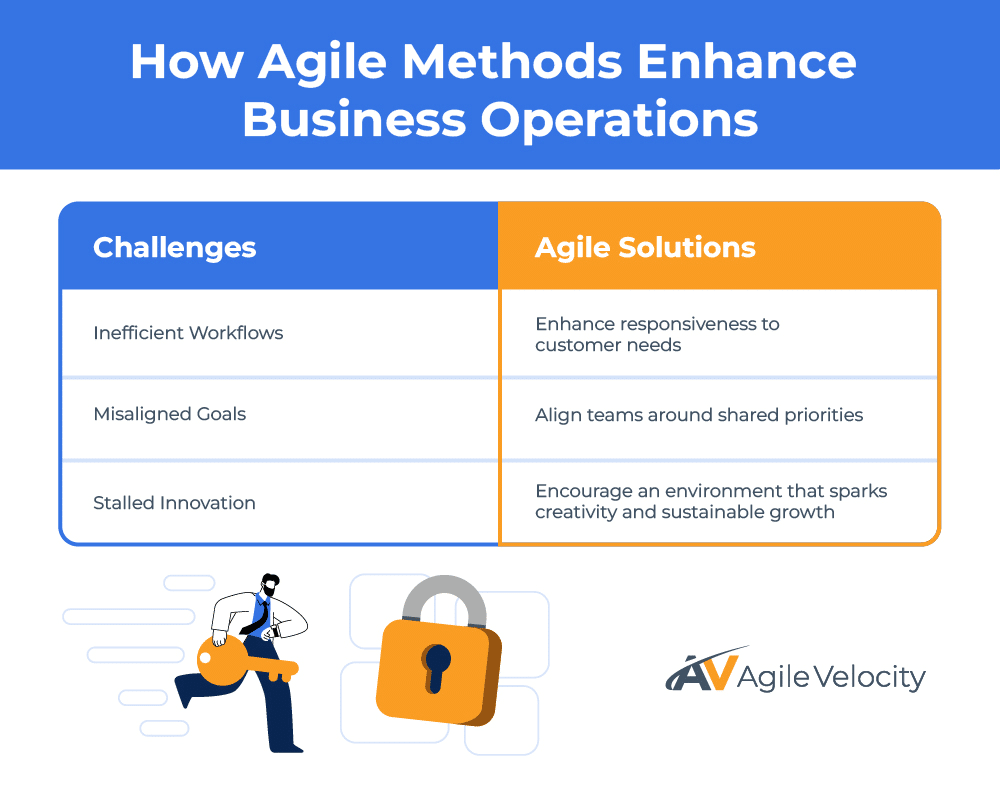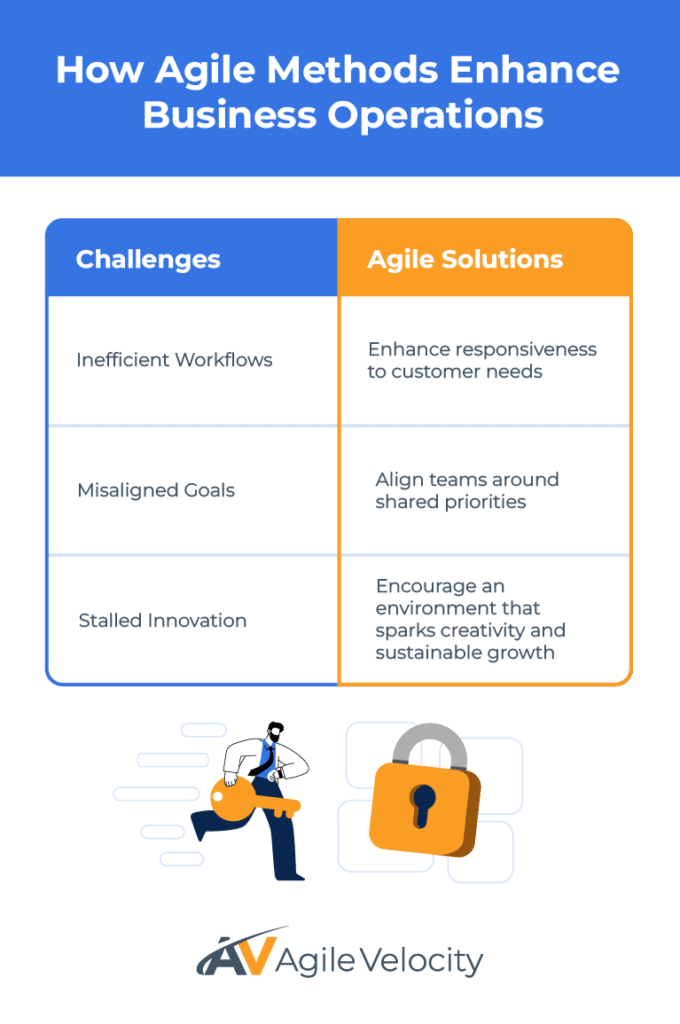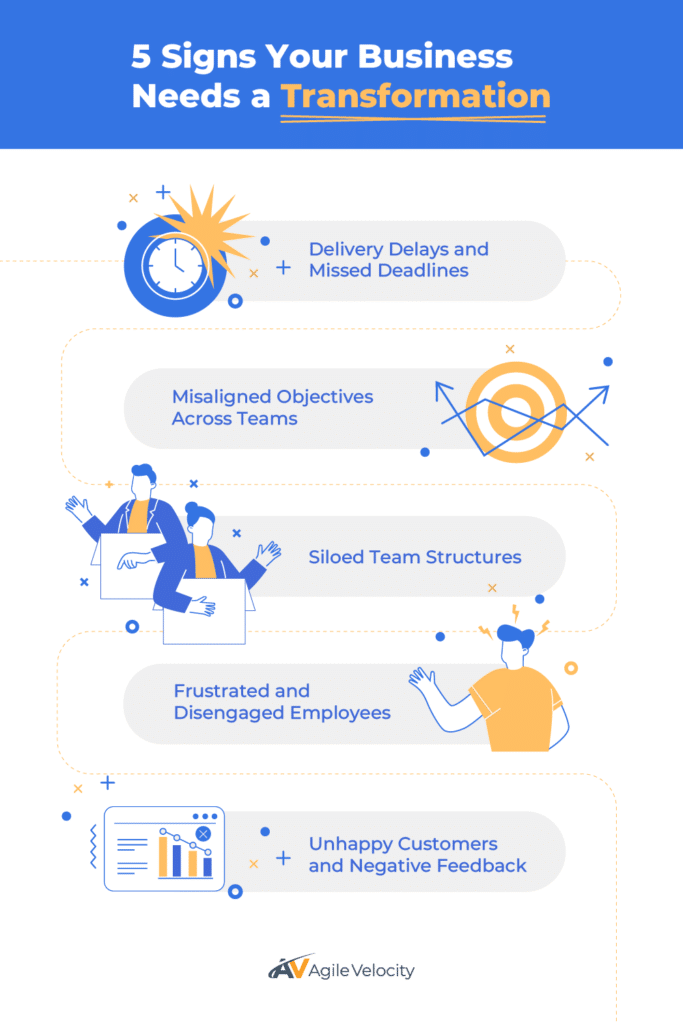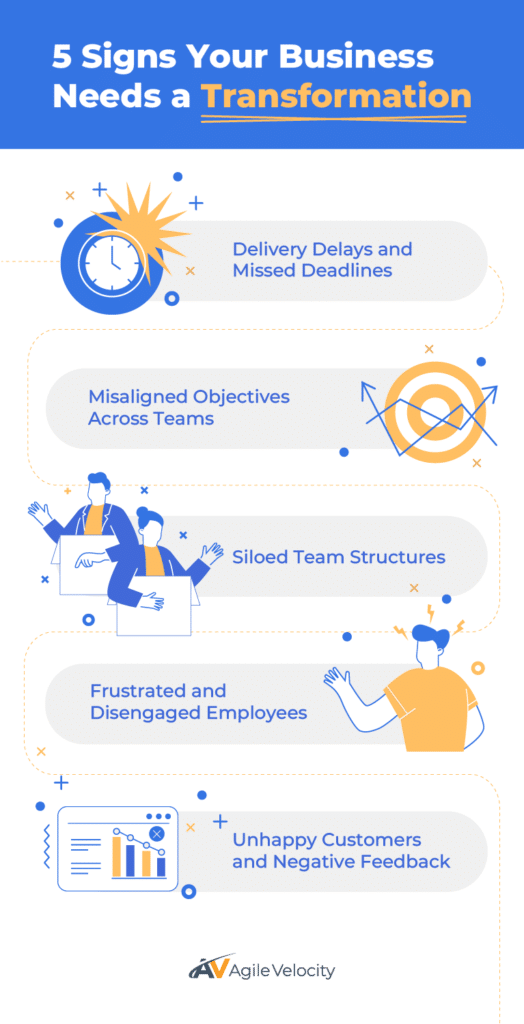Businesses face mounting pressure to stay competitive, efficient, and aligned with customer demands. Yet, many organizations remain tethered to outdated processes, struggling with sluggish deliveries, misaligned goals, and inefficiencies that stifle growth. To thrive, transformation is no longer optional—it’s essential. Agile principles, provide a strategic blend of frameworks, flexible methodologies, and cultural shifts that redefine business operations.
From daily team interactions to high-level strategy, adopting a culture of agility empowers businesses to consistently meet market demands and rapidly adjust to evolving priorities. Beyond process improvements, Agile ignites a mindset shift that fosters continuous improvement and long-term adaptability.
In this article you’ll learn to recognize the signs that your processes need an overhaul and see how business operations consulting can support your journey toward operational excellence. We’ll highlight how Agile Velocity’s tailored strategies and expert consultants create a trusted partnership in helping organizations transition to sustainable agility.
Why Modernizing Business Operations Is Essential


Businesses today are under pressure to deliver value quickly, and remain adaptable. However, many still rely on models that limit efficiency and stifle innovation. Common challenges include:
- Inefficient Workflows: Sluggish approval layers, and rigid hierarchies.
- Misaligned Goals: Departments working at cross-purposes, reducing overall impact.
- Stalled Innovation: Bureaucratic processes that block creativity.
True modernization isn’t just about new tools; it requires a fundamental mindset shift. Agile methods prioritize collaboration, iterative delivery, open communication, and data-driven decisions. By ditching inefficient legacy processes, businesses can:
- Respond faster to customer demands.
- Align teams around shared priorities.
- Encourage an environment that sparks creativit and sustainable growth.
What Is Organizational Agility and Why It Matters
Organizational agility is the ability of a company to quickly adapt its structures, processes, and tools in response to changing circumstances. It emphasizes a proactive mindset—one that embraces learning, iteration, and continuous improvement. Several Agile frameworks guide this adaptability, including Scrum, Kanban, Scaled Agile Framework® (SAFe®), Disciplined Agile® (DA™), and even Large-Scale Scrum (LeSS). Each offers unique structures that support collaboration and align with broader goals.
The Importance of Organizational Agility
- Faster Response to Opportunities: Agile organizations quickly pivot to seize market openings.
- Improved Customer Satisfaction: Frequent feedback loops ensure solutions stay aligned with customer needs.
- Increased Employee Engagement: Teams stay motivated when they see their work driving tangible impact.
- Sustained Adaptability: A culture of continuous improvement equips businesses to remain flexible long term.
By integrating iterative delivery, collaboration, and alignment, organizations foster an environment of rapid learning and resilience.
Common Signs Your Operations Need Transformation
Recognizing when change is required is often the first step toward long-term success. Some indicators that your operations need an Agile Transformation include:


- Delivery Delays and Missed Deadlines: Excessive approvals or outdated processes can slow progress.
- Misaligned Objectives Across Teams: Departments chasing different goals waste resources and create confusion.
- Siloed Team Structures: Lack of cross-functional collaboration leads to duplicated efforts and bottlenecks.
- Frustrated and Disengaged Employees: High turnover or low morale often signals underlying process or cultural issues.
- Unhappy Customers and Negative Feedback: Delayed responses to customer needs weaken loyalty and damage brand reputation.
Addressing these issues through Agile Transformation can align priorities, foster team collaboration, and position your organization to adapt quickly for future growth.
Strategies to Transform Business Operations
Transforming business operations relies on adaptability, transparency, and a willingness to learn. Below are strategies that can fuel your modernization journey.
Adopt Agile Methodologies
Start by exploring the core values and principles behind various Agile frameworks to learn how iterative cycles, transparent processes, and regular feedback improve quality and collaboration. Here are some common Agile frameworks to consider:
- Scrum: Organizes work into time-boxed Sprints, facilitated by the Scrum Master, with the Product Backlog guiding priorities.
- Kanban: Uses a visual board and Work In Progress (WIP) Limits to enhance continuous flow, focusing on smaller tasks and incremental delivery.
- Scaled Agile Framework (SAFe): Provides a set of principles and best practices for scaling Agile from team level to larger programs and enterprise contexts.
- Disciplined Agile® (DA™): Offers a process decision framework that integrates various Agile and Lean approaches, providing flexibility to choose a methodology suited to specific project needs.
- Large-Scale Scrum (LeSS): Extends Scrum principles to larger, multiple team settings ensuring efficient collaboration and alignment around the product vision.
Employ Lean Portfolio Management
Lean Portfolio Management helps teams fund and prioritize initiatives more dynamically, rather than relying on rigid annual cycles. Continuous evaluation and strategic resource allocation allow you to focus on the most valuable work and adapt quickly if priorities shift.
Leverage Agile Coaching
Guidance from experienced coaches can accelerate your transition by helping teams overcome adoption hurdles, instill continuous improvement, and embed an Agile mindset across the organization.
Consider Business Operations Consulting
Transforming business operations can be a daunting task, but engaging with business operations consultants can significantly smooth this journey. These experts provide specialized knowledge and experience to guide transformative efforts, ensuring alignment with strategic goals and customer demands. Consider the following benefits of utilizing business operations consulting:
- Expertise and Best Practices: Consultants bring deep industry insights and proven methodologies, ensuring your transformation strategies are effective and tailored to your needs.
- Objective Perspective: With an external viewpoint, consultants can identify blind spots and inefficiencies in your current processes, offering unbiased recommendations for improvement.
- Focused Resources: They enable you to allocate internal resources to core business activities while they focus on transformation efforts, reducing the strain on your organization.
- Customized Solutions: Consulting firms often provide bespoke solutions tailored to align with your unique business goals and operational challenges, ensuring a smooth and effective transition.
- Accelerated Change: With their specialized skills and tools, consultants can expedite the adoption of new methods, helping your organization achieve operational excellence quickly.
The role of business operations consultants is not just to implement change but to empower organizations to sustain these improvements long-term through strategic direction and ongoing support. By incorporating their expertise, businesses can navigate complex transformations with confidence, ultimately achieving more Agile and efficient operations.
Is Your Organization Truly Ready?
Embrace a Culture of Collaboration
While frameworks and methods provide structure, the culture you foster ultimately determines success. Collaboration is not limited to formal events in Scrum or Iterations in SAFe. It extends to day-to-day interactions and shared decision-making. When teams have the freedom to experiment, they are more open to adapting new techniques and practices that could yield better results.
Leaders can encourage this by acknowledging and rewarding innovative ideas, even if they don’t all succeed. Fostering psychological safety—where employees feel comfortable sharing challenges—produces higher-quality outcomes. This approach goes hand-in-hand with reducing silos. Instead of strict divisions between departments, cross-functional collaboration allows new insights to travel faster, leading to creative solutions.
Effective collaboration also supports continuous improvement. In an Agile environment, teams are not locked into rigid plans. They iterate based on stakeholder input, real-time data, and shifting business priorities. This ongoing collaboration ensures new strategies are quickly tested, refined, or replaced without fear of rigid repercussions.
Ultimately, collaboration fuels a mindset where mutual respect and shared goals overshadow job titles and departmental boundaries. It establishes a foundation for adaptability across the organization. By encouraging open communication, shared accountability, and the freedom to experiment, you create an environment where agility thrives long after the initial transformation.
Collaboration not only fosters synergy among teams but also allows for distributed decision-making. This empowerment ensures that employees at every level are invested in success. No matter what framework or methodology teams are practicing, a culture of trust improves knowledge sharing and fosters innovative solutions. For instance, cross-domain short sessions could encourage marketing, engineering, and finance to collectively identify inefficiencies, turning them into learning opportunities. By inviting diverse perspectives early, organizations can minimize risk and accelerate delivery. This inclusive environment also nurtures accountability, as each contributor understands how their work ties into broader goals. As a result, teams rally around shared victories and collectively problem-solve when obstacles arise.
Tools and Resources for Sustaining Agility
Building a high-performing, adaptable organization requires the right mix of education, technology, and actionable strategies.
Agile Training for Team Empowerment
Agile Training empowers employees to confidently adopt and refine Agile Practices. Courses cover foundational topics, from Sprints and Sprint Planning to deeper dives into product development roles. Interactive sessions strengthen team confidence, making it easier to tackle challenges collectively.
AI-Driven Efficiency Enhancements
Augmenting Agile practices with automation and predictive analytics addresses resource management, and forecasting needs. AI solutions for Agile teams can highlight inefficiencies, automate repetitive steps, and free teams to focus on innovation. AI aligns especially well with frameworks that emphasize fast feedback cycles, where early visibility can drastically improve outcomes.
Metrics and Dashboards for Real-Time Insights
Use measurements like lead time, flow efficiency, and customer satisfaction to gauge progress. Visual dashboards keep teams informed, spotlight bottlenecks, and guide decisions that can be made swiftly without waiting for lengthy approvals.
The Benefits of A Business Operations Transformation
Transforming business operations not only refines processes but also strengthens a company’s resilience and competitiveness. Increasing efficiency leads to reduced operational costs and better resource management, allowing companies to allocate savings toward innovation and growth. By streamlining workflows and aligning teams, organizations can respond swiftly to market changes, giving them a definitive edge over competitors. Improved collaboration and communication across departments foster an environment of continuous improvement, ensuring that the company remains agile and adaptable in a rapidly changing business landscape.
Key benefits include:
- Faster Value Delivery: Iterative cycles help teams validate and launch features more quickly.
- Unified Alignment: Clear visibility and shared backlogs reduce miscommunication between departments.
- Enhanced Innovation and Flexibility: Agile’s adaptability encourages experimentation and turns unexpected shifts into opportunities.
- Elevated Team Engagement: Frequent feedback and well-defined roles make employees feel valued and motivated.
- Higher Customer Satisfaction: Integrating user feedback throughout development strengthens customer loyalty.
How Agile Velocity Facilitates Operational Transformation

Scaling operational transformation is complex, but Agile Velocity’s outcome-based approach ensures each initiative aligns with business objectives. Rather than forcing a standard template, they tailor recommendations to your organization’s specific culture, objectives, and pain points. Consultants provide guidance rooted in data, ensuring you move toward sustainable results, not just surface-level changes.
Agile Velocity’s expertise extends across diverse sectors, enabling them to recommend strategies that meet your organizations unique needs. By focusing on measurable outcomes instead of blind framework implementation, they position your teams to own the transformation journey and continue refining processes well beyond any initial engagement.
Having guided well-known companies through successful transformations, Agile Velocity provides:
- Proven Success in Specific Cases: Agile Velocity has demonstrated measurable improvements in delivery cadence and organizational culture through case studies like the Texas Mutual Insurance case study, highlighting the potential benefits for organizations of varying sizes.
- Expertise in Scaling Agility: Mastery of Scrum, Kanban, SAFe, and more ensures solutions are tailored to your unique environment.
- Data-Driven Approach: Progress is measured using metrics such as lead time, employee engagement, and product quality.
- Customized Solutions: Frameworks are adapted to your culture—rather than forcing a rigid, one-size-fits-all model.
- Commitment to Empowerment: The goal is self-sufficiency. Tools and training empower your teams to continue evolving well after the initial engagement.
Another reason to consider partnering with Agile Velocity is the structured yet flexible approach to transformation. The consultancy begins by conducting an organizational health check, assessing everything from leadership engagement to team-level practices. This diagnostic phase identifies the specific struggles holding your organization back, whether it’s limited cross-functional collaboration, unclear accountability structures, or excessive Work In Progress (WIP) that leads to context switching. With these insights, Agile Velocity designs a roadmap grounded in continuous improvement, ensuring that each newly adopted practice or role addresses the root causes of inefficiency. Throughout the engagement, teams are encouraged to maintain transparent communication, bridging gaps between business strategy and day-to-day tasks. By aligning the right frameworks with your organizational culture, Agile Velocity paves the way toward a responsive and future-ready enterprise.
Agile Velocity’s Customer-Centric Approach
At Agile Velocity, transformation is grounded in partnership. Their core values—openness, collaboration, ownership, continuous improvement, and fun—shape every engagement:
- Openness: Promoting honesty, and transparent communication fosters trust and streamlines adaptation.
- Collaboration: Strategies like facilitated sessions, and cross-functional exploration unite teams behind common goals.
- Ownership: By aligning decisions with data, individuals feel more accountable and inspired to drive meaningful results.
- Continuous Improvement: Emphasizing small, regular changes rather than sporadic overhauls strengthens resilience over time.
- Fun: Transformational work doesn’t have to be grueling; engaging approaches maintain energy and morale.
Begin Your Journey to Agile Transformation Today
Modernizing your business operations might feel daunting, but the advantages of embracing transformation strategies are undeniable. By applying iterative frameworks, focusing on continuous improvement, and leveraging solutions like Business Operations Consulting and Agile Coaching you can build an organization that responds swiftly to change and consistently delivers results.
Take the first step toward redefining how your business operates, and unlock your organization’s full potential with Agile Velocity by your side.



